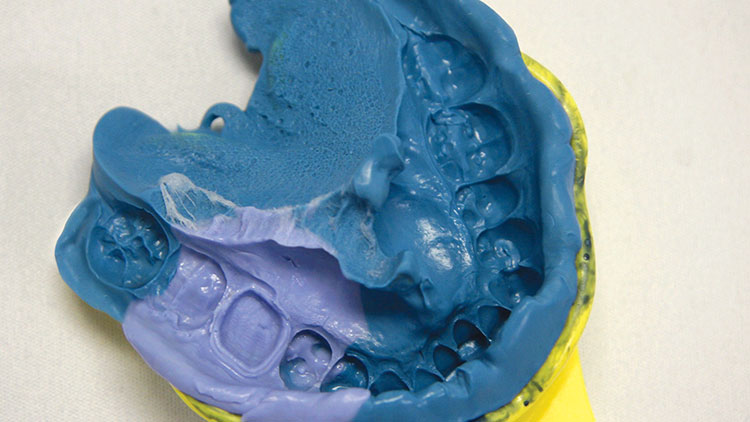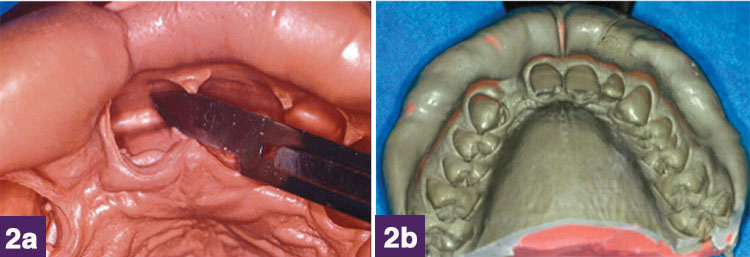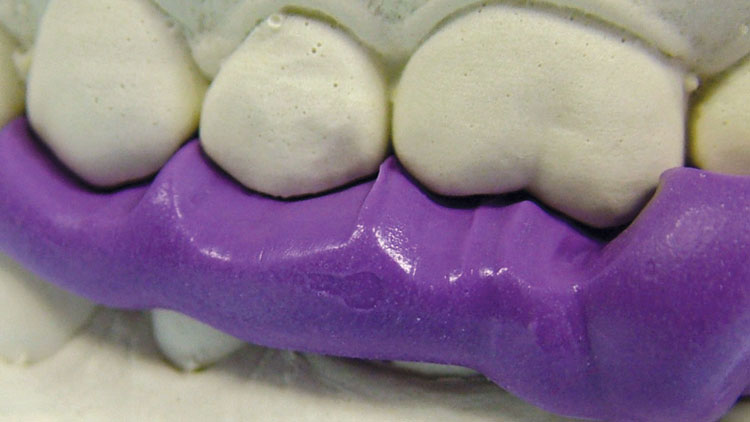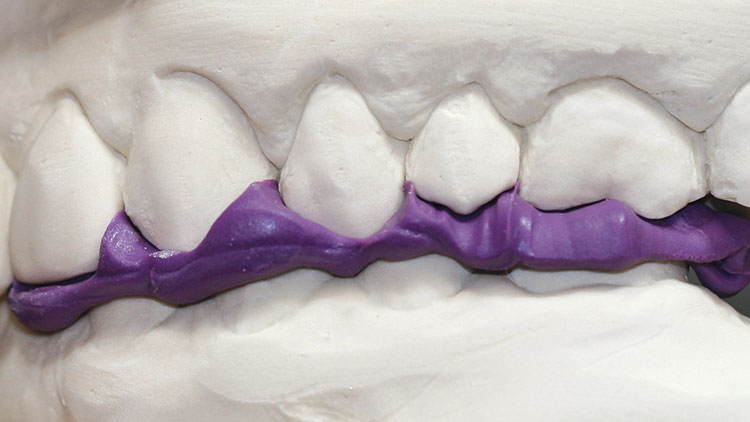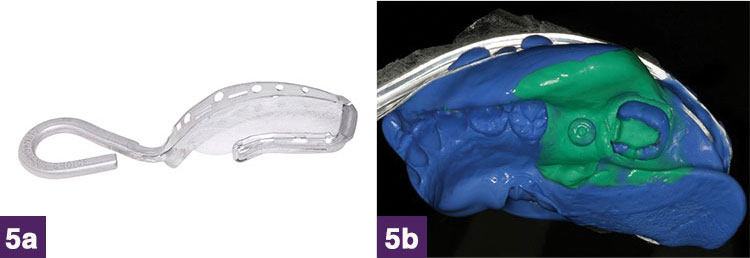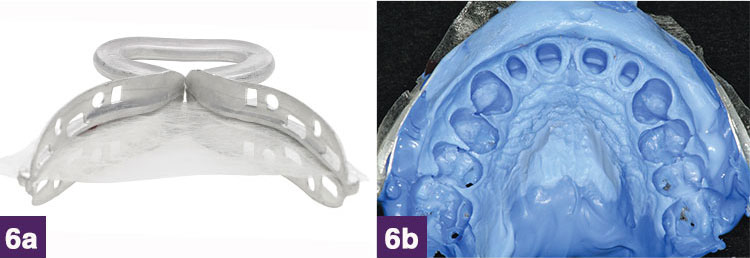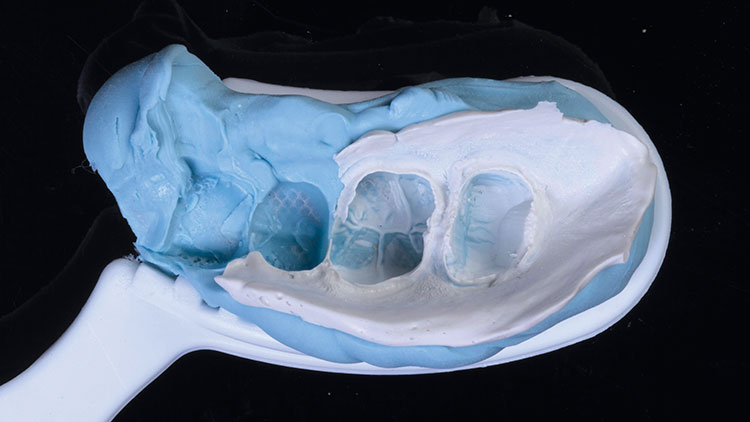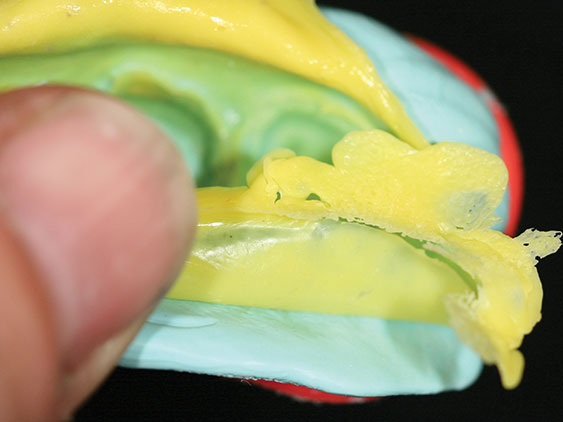The Hydraulic & Hydrophobic Impression Technique: Facts Based on the Research Literature
Crown and bridge impressions can either be described as an all-in-one impression or a two-step impression technique. The most commonly used impression technique, as seen in our dental laboratories, is the all-in-one, which utilizes a full- or dual-arch impression tray with a combination of heavy-body tray material and a flowable wash (Fig. 1). A one-step putty-wash impression technique using a vinyl polysiloxane (VPS) can also be very successful.1 The two-step impression technique uses a putty, heavy-body or medium-body impression material to make a preliminary impression. This preliminary impression can utilize a spacer, be relieved (Figs. 2a, 2b) or vented, have two holes placed to direct the wash, or not be relieved at all. After removal from the mouth, a light-body wash material is added and the tray is reseated in the mouth.
The move toward the two-step impression technique has been driven by the concept that it is easier to capture the margins of the preparation by hydraulic pressure than by a retraction cord or paste system. However, the scientific literature proves that there is a greater probability of introducing errors through the two-step technique than through a one-step impression.2,3
The hydraulic and hydrophobic impression (H&H) technique has been recommended as a method to capture crown preparation margins without the need for gingival retraction. This technique utilizes a preliminary impression of the prepared unit, usually with a vinyl polysiloxane putty, although many units have been taken with a heavy-body VPS as well. The preliminary impression is not relieved in any fashion, nor is a spacer used, and the preliminary impression is lined with a light-body regular or high flow VPS. The patient is then asked to bite back into the impression. Because there is no space for it, the light-body material is extruded from the preliminary impression, and the resultant hydraulic pressure forces it into the sulcus laterally and occlusally throughout the entire impression.
Dental laboratories often see this technique used in a dual-arch impression, with various impression materials and trays, and with seemingly good capture of the margins of the preparation. Why, therefore, do some laboratories experience a remake rate of up to 50% when clinicians utilize this technique?4
In a previous article, "Clinical predictability with dual-impressions: plastic trays are not the answer,"5 the authors summarized the technique and variables based on the dental scientific literature. They were as follows:
- Casts made from dual-arch impressions provide more accurate maximal intercuspal relationships.6 (Figs. 3, 4)
- Plastic dual-arch impression trays compromise the results with consistent discrepancies because the plastic trays distort. This can be due to impingement of the tray on the hard tissues of the mouth, patients biting on the buccal-lingual connector if it does not have sufficient space in the retromolar area, the act of repeated swallowing moving the lingual rim of the tray, and rheologic pressure from the impression material moving the borders of the tray.
- The elastic memory of plastic dual-arch impression trays causes the tray to flex back into its original position and, depending on the impression material used, distort the final impression.7
- Metal impression trays such as the QUAD-TRAY® series (Clinician’s Choice Dental Products, Inc.) eliminate this distortion.8 (Figs. 5a–6b)
- The American Dental Association recommends a specific heavy-body impression material be used with a strain in compression of less than 2%, such as AFFINITY InFlex and Aquasil Ultra Rigid (DENTSPLY Caulk; Milford, Del.). These are extremely stiff, inflexible materials that add stability and eliminate distortion.9
- When burn-through of the plastic tray is seen in the dual-arch impression, it is distorted.
- Dual-arch impressions taken with an inflexible quadrant metal tray are as accurate as full-arch impressions taken with custom trays.10,11
In a 2007 article, Cowie, et al.12 discussed the two-step impression technique. Challenges with the two-step impression technique were identified as follows:
- Reseating the impression in the mouth often results in a step in the impression (Fig. 7).
- This technique more often results in occlusal inaccuracies (Figs. 8a, 8b).13
- There is an increased risk of the wash not completely bonding to the set putty material due to salivary contamination (Fig. 9).14
- Second pours can often not be made, as the wash separates when the working model is removed from the impression.
- Hydrostatic pressure can cause a rebound effect.
- Any active force (biting into the impression) causes an increase in elastic recoil, resulting in a reduction in the size of the prosthesis.15
- For this technique to work, if the preliminary impression is not relieved, an increase in degree of preparation taper is required, but this negatively affects the clinical performance/retention of the crown and bridge prosthesis.16
- Increased layers of die spacer, the amounts of which are arbitrarily chosen, are needed for this technique to allow for the restoration to fit, which also compromises the performance of cements or bonding systems used. Cements work best in thin layers of 40 microns or less.
It has often been said that two materials cannot occupy the same space at the same time, and this is especially true when taking a two-step H&H impression. The lack of understanding of the flexibility of many plastic tray systems, elastic recoil of impression materials used, and the hydraulic pressure resulting in unseen distortion due to the elastic recoil or rebound, creates the variability and inaccuracy in the clinical end result when trying to seat the crown and bridge prosthesis.
Scientific documentation from the literature includes these direct quotes from the authors’ publications:
"The disadvantages of this two-stage technique include the additional time of having to wait for two materials to set, contamination of the putty with saliva which may prevent light-body adhering to it, and difficulty in reseating the set putty in the mouth. The most accurate impression is usually achieved using heavy-body and light-body addition silicone in conjunction with a rigid tray."14
"Based on in vitro studies, one-stage impressions showed predominantly superior accuracy compared to two-stage impressions." Even though the preliminary impression was relieved to make room for the wash in this study, "in light of this study’s results, the benefit of two-stage putty-wash impressions with regard to a more complete rendering of subgingival finishing lines should be questioned."17
"The two-step putty-wash technique has its problems, the most common of which is invisible when the impression is recorded, only becoming apparent when the restoration is tried in and fails to seat satisfactorily. The problem that causes invisible, but sometimes gross, distortions is recoil. Considerable forces are needed to seat putty impressions, which can result either in outward flexion of the tray wall or the incorporation of residual stresses within the material. On removing the tray from the mouth, the tray walls rebound, resulting in dies which are undersized bucco-lingually."18
In a study looking at the H&H technique: "During reseating of the tray, the wash induces tension on the high-viscosity material, thus inducing deformation on the already set impression material. After setting and upon removal, the high-consistency material is likely to exhibit elastic recovery, returning to its original position, thus resulting in smaller dies. Although the elevated hardness of the high-viscosity material indicates little flexibility and a high degree of rigidity, it was not possible to avoid the dimensional alteration of the vinyl polysiloxane in the two-step technique without relief."19
"The impression technique with a spacer was more accurate in all dimensions as compared to rewash technique."20
"An increase in scattering was noted for all disposable stock plastic tray groups, indicating that impression-taking is less reliable with this type of tray. The viscosity of the wash material significantly affected the impression’s accuracy. A possible explanation is the elastic deformation of the set putty material and tray caused by reduced flow of the higher viscosity wash material during the second stage of impression-taking. The use of metal trays is superior regarding the dimensional accuracy and reliability of impression-taking, and should therefore be preferred."21
Note that these results documenting the variability and lack of accuracy of the H&H technique are supported by numerous other scientific documents.22,23,24,25,26
In his study "A clinical evaluation of fixed partial denture impressions," published in the Journal of Prosthetic Dentistry,27 Samet looked at the quality of impressions sent to commercial laboratories for the fabrication of fixed prostheses and found that of the impressions, 89.1% had one or more observable errors. Unfortunately, the errors introduced by tray flexure, material distortion and elastic rebound cannot be identified by sight alone, but are patently obvious when the crown and bridge unit does not fit.
It is easy for the clinician to blame the laboratory if a unit does not fit, but it is often the clinician’s lack of understanding of material science and scientifically sound, proper clinical protocol that affects the final crown and bridge outcome. Suggested clinical protocol should be evidence-based in the scientific literature, and not based on hearsay or empirical personal experiences.
DISCLOSURES
Dr. Leendert Boksman is a part-time consultant to Clinical Research Dental and Clinician’s Choice.
Dr. Pameijer has no disclosures.
Dr. Gildo C. Santos Jr. is a part-time consultant for Research & Development at Clinical Research Dental and Clinician’s Choice.
Dr. Len Boksman is a former tenured associate professor of operative dentistry at the Western University’s Schulich School of Medicine and Dentistry. He has recently retired from private practice and volunteers his time as an adjunct professor for the University of Technology Dental School, Jamaica. He can be reached at lenpat28@gmail.com.
Dr. Cornelis H. Pameijer is professor emeritus at University of Connecticut School of Dental Medicine.
Dr. Gildo Coelho Santos Jr. is an assistant professor and chair of the department of Restorative Dentistry for Western University’s Schulich School of Medicine and Dentistry.
References
- ^Pameijer CH. A one-step putty-wash impression technique utilizing vinyl polysiloxanes. Quintessence Int Dent Dig. 1983 Aug;14(8):861-3.
- ^Siemer A, Balkenhol M, Trost M, Ferger P, Woestmann B. Accuracy of one-step vs. two-step putty-wash impressions. J Dent Res AADR Abstract 82nd General session March 10-13, 2004.
- ^Mandikos MN. Polyvinyl siloxane impression materials: an update on clinical use. Aust Dent J. 1998 Dec;43(6):428-34.
- ^Personal communication with various dental laboratories in Canada and the U.S.
- ^Boksman L. Clinical predictability with dual-arch impressions: plastic trays are not the answer. Dental Town. 2009;10(9):18-21.
- ^Cox JR. A clinical study comparing marginal and occlusal accuracy of crowns fabricated from double-arch and complete-arch impressions. Aust Dent J. 2005 Jun;50(2):90-4.
- ^Cho GC, Chee WW. Distortion of disposable plastic stock trays when used with putty vinyl polysiloxane impression materials. J Prosthet Dent. 2004 Oct;92(4):354-8.
- ^Christensen GJ. Ensuring accuracy and predictability with double-arch impressions. J Am Dent Assoc. 2008 Aug;139(8):1123-5.
- ^ADA Professional Product Review. Elastomeric Impression Materials. 2012;Vol 7 Issue 1.
- ^Cox JR, Brandt RL, Hughes HJ. A clinical pilot study of the dimensional accuracy of double-arch and complete-arch impressions. J Prosthet Dent. 2002 May;87(5):510-5.
- ^Larson TD, Nielsen MA, Brackett WW. The accuracy of dual-arch impressions: a pilot study. J Prosthet Dent. 2002 Jun;87(6):625-7.
- ^Cowie RR, Boksman L. A philosophical approach to selecting an impression technique. Oral Health. 2007 Mar;18-22.
- ^Christensen GJ. What category of impression material is best for your practice? J Amer Dent Assoc. 1997 Jul;128(7):1026-8.
- ^Millar B. How to make a good impression (crown and bridge). Br Dent J. 2001 Oct 13;191(7):402-3, 405.
- ^Sadat-Khonsri MR, Fenske C, Maus S. Untersuchung zur korrekturabformung. ZWR. 1999;108:288-91.
- ^Fenske C. The influence of five impression techniques on the dimensional accuracy of master models. Braz Dent J. 2000;11(1):19-27.
- ^Luthardt RG, Walter MH, Weber A, Koch R, Rudolph H. Clinical parameters influencing the accuracy of 1- and 2-stage impressions: a randomized controlled trial. Int J Prosthodont. 2008 Jul-Aug;21(4):322-7.
- ^Wassell RW, Barker D, Walls AW. Crowns and other extra-coronal restorations: impression materials and technique. Br Dent J. 2002 Jun 29;192(12):679-90.
- ^Franco EB, da Cunha LF, Herrera FS, Benetti AR. Accuracy of Single-Step versus 2-Step Double-Mix Impression Technique. ISRN Dent. 2011. Article ID 341546. 1-7.
- ^Amini P, Tavallaei M. Effects of Rewash on the Accuracy of Stone Dies Produced by Putty-Wash Technique. J of Kerman U of Med Sci. 2013;20(2).
- ^Balkenhol M, Ferger BP, Wöstmann B. Dimensional accuracy of 2-stage putty-wash impressions: influence of impression trays and viscosity. Int J Prosthodont. 2007 Nov-Dec;20(6):573-5.
- ^Caputi S, Vavara G. Dimensional accuracy of resultant casts made by a monophase, one-step and two-step, and a novel two-step putty/light-body impression technique: an in vitro study. J Prosthet Dent. 2008 Apr;99(4):274-81.
- ^Hung SH, Purk JH, Tira DE, Eick JD. Accuracy of one-step versus two-step putty wash addition silicone impression technique. J Prosthet Dent. 1992 May;67(5):583-9.
- ^Johnson GH, Craig RG. Accuracy of addition silicones as a function of technique. J Prosthet Dent. 1986 Feb;55(2):197-203.
- ^Petersen GF, Asmussen E. Distortion of impression materials used in the double-mix technique. Scand J Dent Res. 1991 Aug;99(4):343-8.
- ^Fusayama T, Iwaku M, Daito K, Nurosaki N, Takatsu T. Accuracy of the laminated single impression technique with silicone materials. J Prosthet Dent. 1974 Sep;32(3):270-6.
- ^Samet N, Shohat M, Livny A, Weiss EI. A clinical evaluation of fixed partial denture impressions. J Prosthet Dent. 2005 Aug;94(2):112-7.





